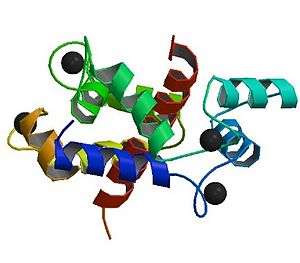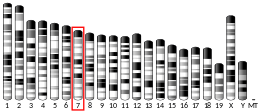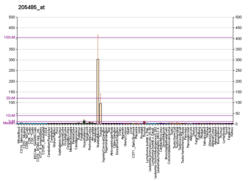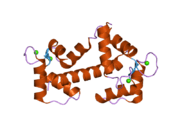RYR1
Ryanodine receptor 1 (RYR-1) also known as skeletal muscle calcium release channel or skeletal muscle-type ryanodine receptor is a protein found primarily in skeletal muscle. In humans, it is encoded by the RYR1 gene.[5][6]
Function
RYR1 functions as a calcium release channel in the sarcoplasmic reticulum, as well as a connection between the sarcoplasmic reticulum and the transverse tubule.[7] RYR1 is associated with the dihydropyridine receptor (L-type calcium channels) within the sarcolemma of the T-tubule, which opens in response to depolarization, and thus effectively means that the RYR1 channel opens in response to depolarization of the cell.
RYR1 plays a signaling role during embryonic skeletal myogenesis. A correlation exists between RYR1-mediated Ca2+ signaling and the expression of multiple molecules involved in key myogenic signaling pathways.[8] Of these, more than 10 differentially expressed genes belong to the Wnt family which are essential for differentiation. This coincides with the observation that without RYR1 present, muscle cells appear in smaller groups, are underdeveloped, and lack organization. Fiber type composition is also affected, with less type 1 muscle fibers when there are decreased amounts of RYR1.[9] These findings demonstrate RYR1 has a non-contractile role during muscle development.
RYR1 is mechanically linked to neuromuscular junctions for the calcium release-calcium induced biological process. While nerve-derived signals are required for acetylcholine receptor cluster distribution, there is evidence to suggest RYR1 activity is an important mediator in the formation and patterning of these receptors during embryological development.[10] The signals from the nerve and RYR1 activity appear to counterbalance each other. When RYR1 is eliminated, the acetylcholine receptor clusters appear in an abnormally narrow pattern, yet without signals from the nerve, the clusters are scattered and broad. Although their direct role is still unknown, RYR1 is required for proper distribution of acetylcholine receptor clusters.
Clinical significance
Mutations in the RYR1 gene are associated with malignant hyperthermia susceptibility, central core disease, minicore myopathy with external ophthalmoplegia and samaritan myopathy, a benign congenital myopathy.[11] Alternatively spliced transcripts encoding different isoforms have been demonstrated.[7] Dantrolene may be the only known drug that is effective during cases of malignant hyperthermia.
Interactions
RYR1 has been shown to interact with:
- calmodulin[12][13]
- FKBP1A[14][15][16]
- HOMER1[17][18]
- HOMER2[18]
- HOMER3[18] and
- TRDN.[19][20][21][22]
See also
References
- GRCh38: Ensembl release 89: ENSG00000196218 - Ensembl, May 2017
- GRCm38: Ensembl release 89: ENSMUSG00000030592 - Ensembl, May 2017
- "Human PubMed Reference:". National Center for Biotechnology Information, U.S. National Library of Medicine.
- "Mouse PubMed Reference:". National Center for Biotechnology Information, U.S. National Library of Medicine.
- Fujii J, Otsu K, Zorzato F, de Leon S, Khanna VK, Weiler JE, O'Brien PJ, MacLennan DH (July 1991). "Identification of a mutation in porcine ryanodine receptor associated with malignant hyperthermia". Science. 253 (5018): 448–51. doi:10.1126/science.1862346. PMID 1862346.
- Wu S, Ibarra MC, Malicdan MC, Murayama K, Ichihara Y, Kikuchi H, Nonaka I, Noguchi S, Hayashi YK, Nishino I (June 2006). "Central core disease is due to RYR1 mutations in more than 90% of patients". Brain. 129 (Pt 6): 1470–80. doi:10.1093/brain/awl077. PMID 16621918.
- "Entrez Gene: RYR1 ryanodine receptor 1 (skeletal)".
- Filipova D, Walter AM, Gaspar JA, Brunn A, Linde NF, Ardestani MA, Deckert M, Hescheler J, Pfitzer G, Sachinidis A, Papadopoulos S (April 2016). "Corrigendum: Gene profiling of embryonic skeletal muscle lacking type I ryanodine receptor Ca(2+) release channel". Scientific Reports. 6: 24450. doi:10.1038/srep24450. PMC 4840354. PMID 27102063.
- Willemse H, Theodoratos A, Smith PN, Dulhunty AF (February 2016). "Unexpected dependence of RyR1 splice variant expression in human lower limb muscles on fiber-type composition". Pflügers Archiv. 468 (2): 269–78. doi:10.1007/s00424-015-1738-9. PMID 26438192.
- Hanson MG, Niswander LA (December 2014). "An explant muscle model to examine the refinement of the synaptic landscape". Journal of Neuroscience Methods. 238: 95–104. doi:10.1016/j.jneumeth.2014.09.013. PMC 4252626. PMID 25251554.
- Böhm J, Leshinsky-Silver E, Vassilopoulos S, Le Gras S, Lerman-Sagie T, Ginzberg M, Jost B, Lev D, Laporte J (October 2012). "Samaritan myopathy, an ultimately benign congenital myopathy, is caused by a RYR1 mutation". Acta Neuropathologica. 124 (4): 575–81. doi:10.1007/s00401-012-1007-3. PMID 22752422.
- Fruen BR, Balog EM, Schafer J, Nitu FR, Thomas DD, Cornea RL (January 2005). "Direct detection of calmodulin tuning by ryanodine receptor channel targets using a Ca2+-sensitive acrylodan-labeled calmodulin". Biochemistry. 44 (1): 278–84. CiteSeerX 10.1.1.578.9139. doi:10.1021/bi048246u. PMID 15628869.
- Cornea RL, Nitu F, Gruber S, Kohler K, Satzer M, Thomas DD, Fruen BR (April 2009). "FRET-based mapping of calmodulin bound to the RyR1 Ca2+ release channel". Proceedings of the National Academy of Sciences of the United States of America. 106 (15): 6128–33. doi:10.1073/pnas.0813010106. PMC 2662960. PMID 19332786.
- Avila G, Lee EH, Perez CF, Allen PD, Dirksen RT (June 2003). "FKBP12 binding to RyR1 modulates excitation-contraction coupling in mouse skeletal myotubes". The Journal of Biological Chemistry. 278 (25): 22600–8. doi:10.1074/jbc.M205866200. PMID 12704193.
- Bultynck G, De Smet P, Rossi D, Callewaert G, Missiaen L, Sorrentino V, De Smedt H, Parys JB (March 2001). "Characterization and mapping of the 12 kDa FK506-binding protein (FKBP12)-binding site on different isoforms of the ryanodine receptor and of the inositol 1,4,5-trisphosphate receptor". The Biochemical Journal. 354 (Pt 2): 413–22. doi:10.1042/bj3540413. PMC 1221670. PMID 11171121.
- Gaburjakova M, Gaburjakova J, Reiken S, Huang F, Marx SO, Rosemblit N, Marks AR (May 2001). "FKBP12 binding modulates ryanodine receptor channel gating". The Journal of Biological Chemistry. 276 (20): 16931–5. doi:10.1074/jbc.M100856200. PMID 11279144.
- Hwang SY, Wei J, Westhoff JH, Duncan RS, Ozawa F, Volpe P, Inokuchi K, Koulen P (August 2003). "Differential functional interaction of two Vesl/Homer protein isoforms with ryanodine receptor type 1: a novel mechanism for control of intracellular calcium signaling". Cell Calcium. 34 (2): 177–84. doi:10.1016/S0143-4160(03)00082-4. PMID 12810060.
- Feng W, Tu J, Yang T, Vernon PS, Allen PD, Worley PF, Pessah IN (November 2002). "Homer regulates gain of ryanodine receptor type 1 channel complex". The Journal of Biological Chemistry. 277 (47): 44722–30. doi:10.1074/jbc.M207675200. PMID 12223488.
- Lee JM, Rho SH, Shin DW, Cho C, Park WJ, Eom SH, Ma J, Kim DH (February 2004). "Negatively charged amino acids within the intraluminal loop of ryanodine receptor are involved in the interaction with triadin". The Journal of Biological Chemistry. 279 (8): 6994–7000. doi:10.1074/jbc.M312446200. PMID 14638677.
- Caswell AH, Motoike HK, Fan H, Brandt NR (January 1999). "Location of ryanodine receptor binding site on skeletal muscle triadin". Biochemistry. 38 (1): 90–7. doi:10.1021/bi981306+. PMID 9890886.
- Guo W, Campbell KP (April 1995). "Association of triadin with the ryanodine receptor and calsequestrin in the lumen of the sarcoplasmic reticulum". The Journal of Biological Chemistry. 270 (16): 9027–30. doi:10.1074/jbc.270.16.9027. PMID 7721813.
- Groh S, Marty I, Ottolia M, Prestipino G, Chapel A, Villaz M, Ronjat M (April 1999). "Functional interaction of the cytoplasmic domain of triadin with the skeletal ryanodine receptor". The Journal of Biological Chemistry. 274 (18): 12278–83. doi:10.1074/jbc.274.18.12278. PMID 10212196.
Further reading
- Treves S, Anderson AA, Ducreux S, Divet A, Bleunven C, Grasso C, Paesante S, Zorzato F (October 2005). "Ryanodine receptor 1 mutations, dysregulation of calcium homeostasis and neuromuscular disorders". Neuromuscular Disorders. 15 (9–10): 577–87. doi:10.1016/j.nmd.2005.06.008. PMID 16084090.
External links
- RYR1+protein,+human at the US National Library of Medicine Medical Subject Headings (MeSH)
- GeneReviews/NIH/UW entry on Multiminicore Disease
- GeneReviews/NCBI/NIH/UW entry on Malignant Hyperthermia Susceptibility
- RYR1 Variation Database
This article incorporates text from the United States National Library of Medicine, which is in the public domain.






